Critical Appraisal: Qualitative Study on Urinary Catheter Needs
VerifiedAdded on 2023/06/14
|8
|1953
|226
Report
AI Summary
This report presents a critical appraisal of a qualitative research article focusing on the information needs of individuals using long-term indwelling urinary catheters. The appraisal assesses the validity, results, and local applicability of the study, examining aspects such as the clarity of research aims, appropriateness of the qualitative methodology, recruitment strategy, data collection methods, ethical considerations, and rigor of data analysis. The report evaluates the value of the research in addressing complex issues related to catheter use, including patient education on different types of catheters, prevention of infections, and management of social life challenges. The appraisal also comments on the credibility of the authors and the journal, ultimately concluding that the research provides valuable insights for healthcare professionals to better educate and support patients using indwelling urinary catheters.
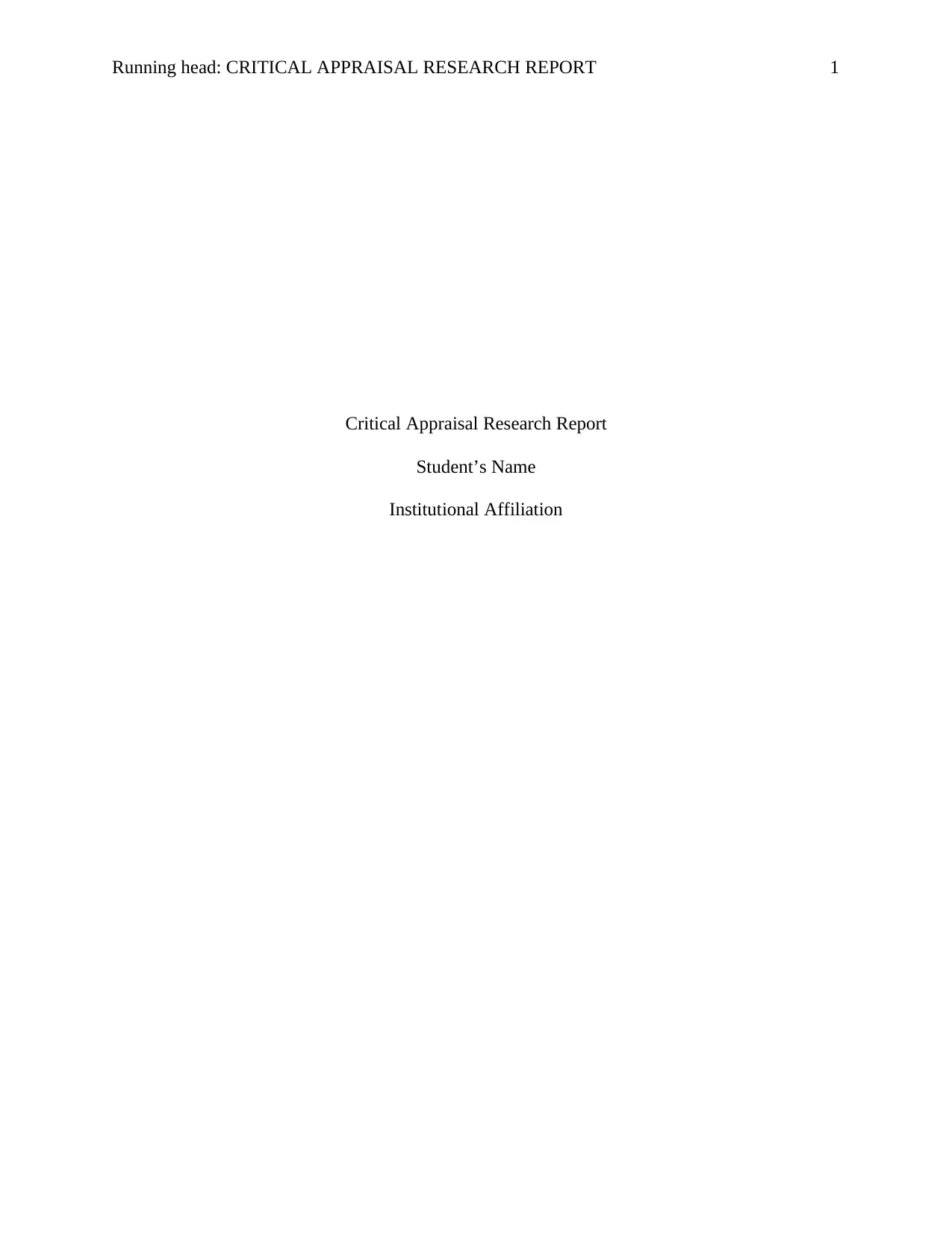
Running head: CRITICAL APPRAISAL RESEARCH REPORT 1
Critical Appraisal Research Report
Student’s Name
Institutional Affiliation
Critical Appraisal Research Report
Student’s Name
Institutional Affiliation
Paraphrase This Document
Need a fresh take? Get an instant paraphrase of this document with our AI Paraphraser
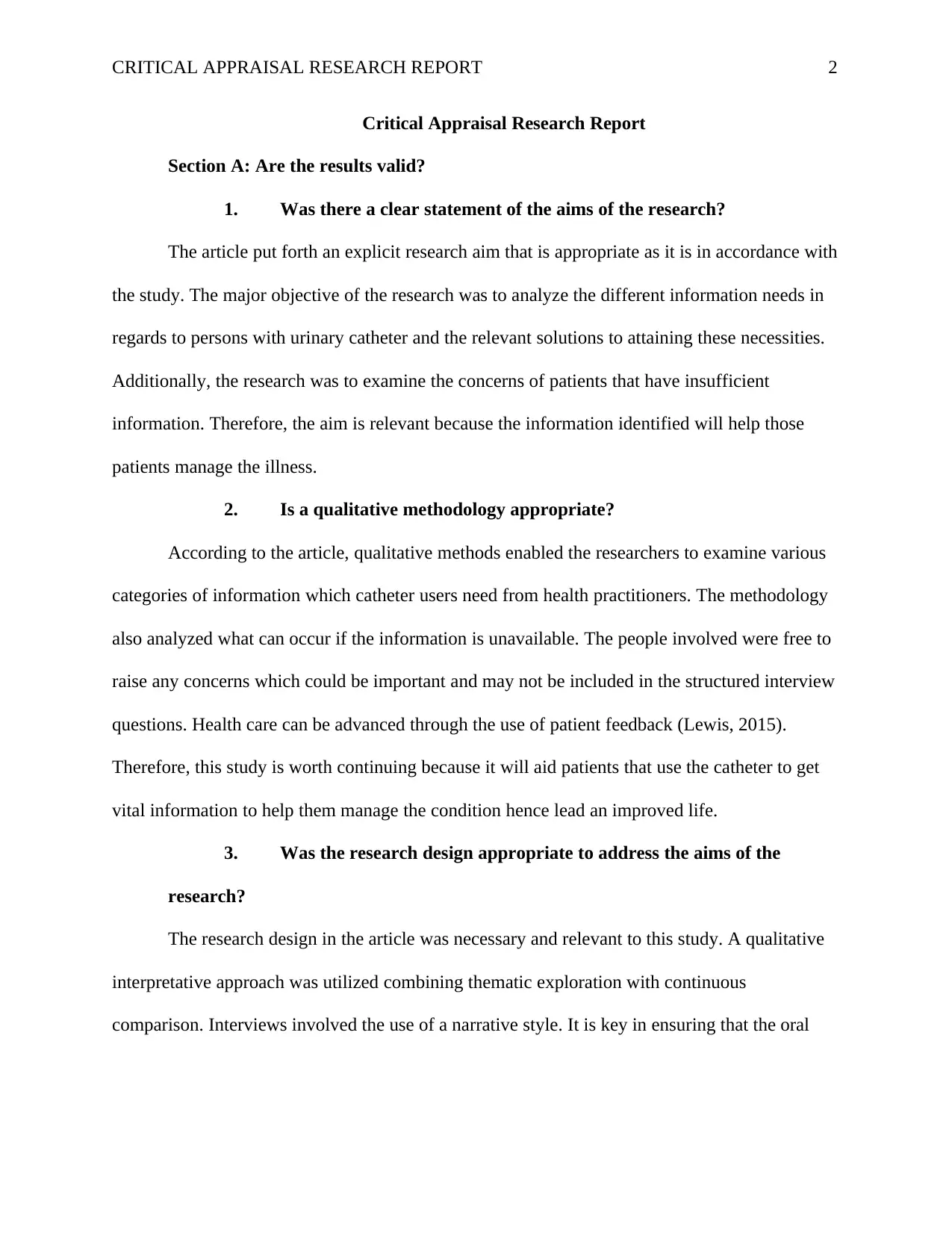
CRITICAL APPRAISAL RESEARCH REPORT 2
Critical Appraisal Research Report
Section A: Are the results valid?
1. Was there a clear statement of the aims of the research?
The article put forth an explicit research aim that is appropriate as it is in accordance with
the study. The major objective of the research was to analyze the different information needs in
regards to persons with urinary catheter and the relevant solutions to attaining these necessities.
Additionally, the research was to examine the concerns of patients that have insufficient
information. Therefore, the aim is relevant because the information identified will help those
patients manage the illness.
2. Is a qualitative methodology appropriate?
According to the article, qualitative methods enabled the researchers to examine various
categories of information which catheter users need from health practitioners. The methodology
also analyzed what can occur if the information is unavailable. The people involved were free to
raise any concerns which could be important and may not be included in the structured interview
questions. Health care can be advanced through the use of patient feedback (Lewis, 2015).
Therefore, this study is worth continuing because it will aid patients that use the catheter to get
vital information to help them manage the condition hence lead an improved life.
3. Was the research design appropriate to address the aims of the
research?
The research design in the article was necessary and relevant to this study. A qualitative
interpretative approach was utilized combining thematic exploration with continuous
comparison. Interviews involved the use of a narrative style. It is key in ensuring that the oral
Critical Appraisal Research Report
Section A: Are the results valid?
1. Was there a clear statement of the aims of the research?
The article put forth an explicit research aim that is appropriate as it is in accordance with
the study. The major objective of the research was to analyze the different information needs in
regards to persons with urinary catheter and the relevant solutions to attaining these necessities.
Additionally, the research was to examine the concerns of patients that have insufficient
information. Therefore, the aim is relevant because the information identified will help those
patients manage the illness.
2. Is a qualitative methodology appropriate?
According to the article, qualitative methods enabled the researchers to examine various
categories of information which catheter users need from health practitioners. The methodology
also analyzed what can occur if the information is unavailable. The people involved were free to
raise any concerns which could be important and may not be included in the structured interview
questions. Health care can be advanced through the use of patient feedback (Lewis, 2015).
Therefore, this study is worth continuing because it will aid patients that use the catheter to get
vital information to help them manage the condition hence lead an improved life.
3. Was the research design appropriate to address the aims of the
research?
The research design in the article was necessary and relevant to this study. A qualitative
interpretative approach was utilized combining thematic exploration with continuous
comparison. Interviews involved the use of a narrative style. It is key in ensuring that the oral
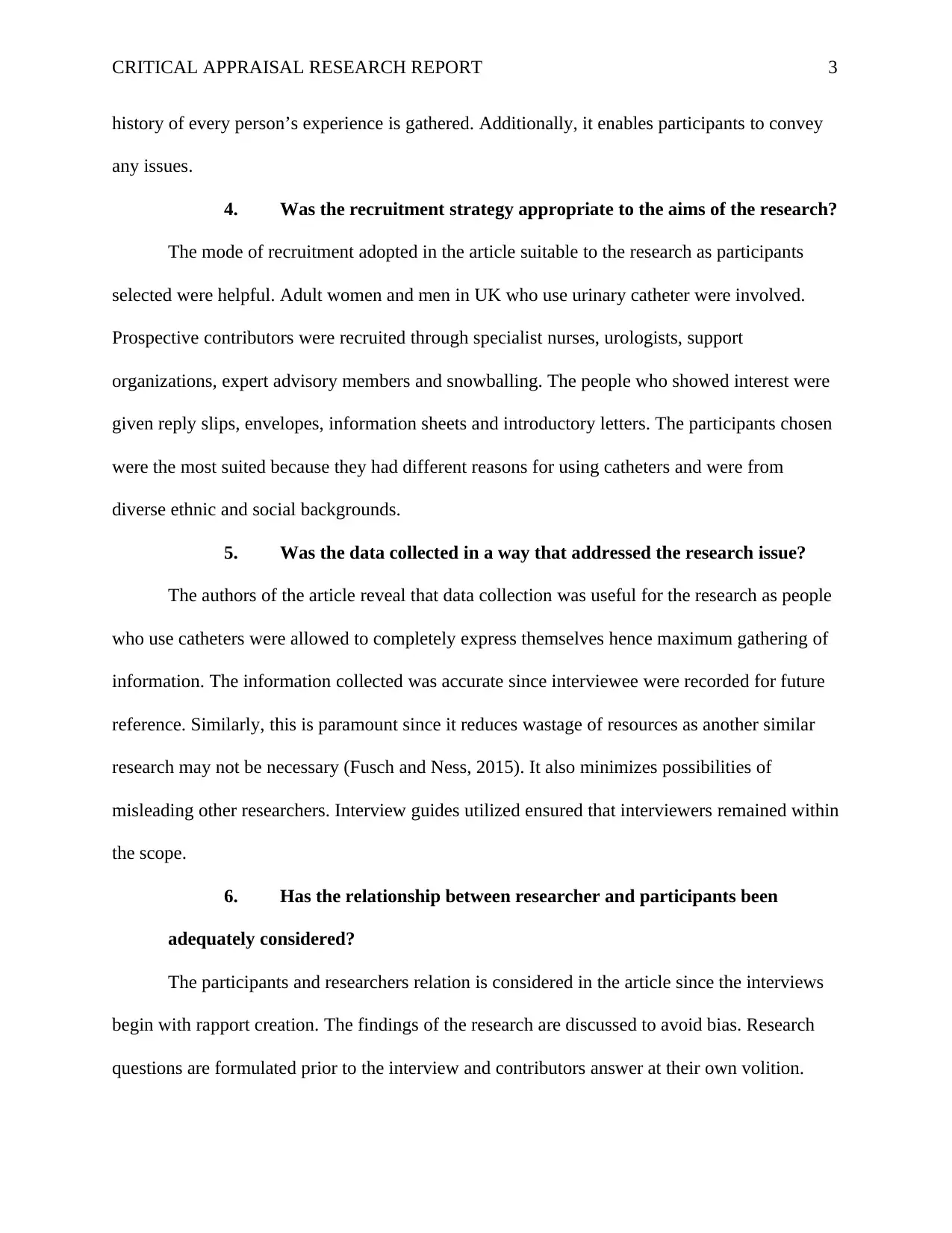
CRITICAL APPRAISAL RESEARCH REPORT 3
history of every person’s experience is gathered. Additionally, it enables participants to convey
any issues.
4. Was the recruitment strategy appropriate to the aims of the research?
The mode of recruitment adopted in the article suitable to the research as participants
selected were helpful. Adult women and men in UK who use urinary catheter were involved.
Prospective contributors were recruited through specialist nurses, urologists, support
organizations, expert advisory members and snowballing. The people who showed interest were
given reply slips, envelopes, information sheets and introductory letters. The participants chosen
were the most suited because they had different reasons for using catheters and were from
diverse ethnic and social backgrounds.
5. Was the data collected in a way that addressed the research issue?
The authors of the article reveal that data collection was useful for the research as people
who use catheters were allowed to completely express themselves hence maximum gathering of
information. The information collected was accurate since interviewee were recorded for future
reference. Similarly, this is paramount since it reduces wastage of resources as another similar
research may not be necessary (Fusch and Ness, 2015). It also minimizes possibilities of
misleading other researchers. Interview guides utilized ensured that interviewers remained within
the scope.
6. Has the relationship between researcher and participants been
adequately considered?
The participants and researchers relation is considered in the article since the interviews
begin with rapport creation. The findings of the research are discussed to avoid bias. Research
questions are formulated prior to the interview and contributors answer at their own volition.
history of every person’s experience is gathered. Additionally, it enables participants to convey
any issues.
4. Was the recruitment strategy appropriate to the aims of the research?
The mode of recruitment adopted in the article suitable to the research as participants
selected were helpful. Adult women and men in UK who use urinary catheter were involved.
Prospective contributors were recruited through specialist nurses, urologists, support
organizations, expert advisory members and snowballing. The people who showed interest were
given reply slips, envelopes, information sheets and introductory letters. The participants chosen
were the most suited because they had different reasons for using catheters and were from
diverse ethnic and social backgrounds.
5. Was the data collected in a way that addressed the research issue?
The authors of the article reveal that data collection was useful for the research as people
who use catheters were allowed to completely express themselves hence maximum gathering of
information. The information collected was accurate since interviewee were recorded for future
reference. Similarly, this is paramount since it reduces wastage of resources as another similar
research may not be necessary (Fusch and Ness, 2015). It also minimizes possibilities of
misleading other researchers. Interview guides utilized ensured that interviewers remained within
the scope.
6. Has the relationship between researcher and participants been
adequately considered?
The participants and researchers relation is considered in the article since the interviews
begin with rapport creation. The findings of the research are discussed to avoid bias. Research
questions are formulated prior to the interview and contributors answer at their own volition.
⊘ This is a preview!⊘
Do you want full access?
Subscribe today to unlock all pages.

Trusted by 1+ million students worldwide
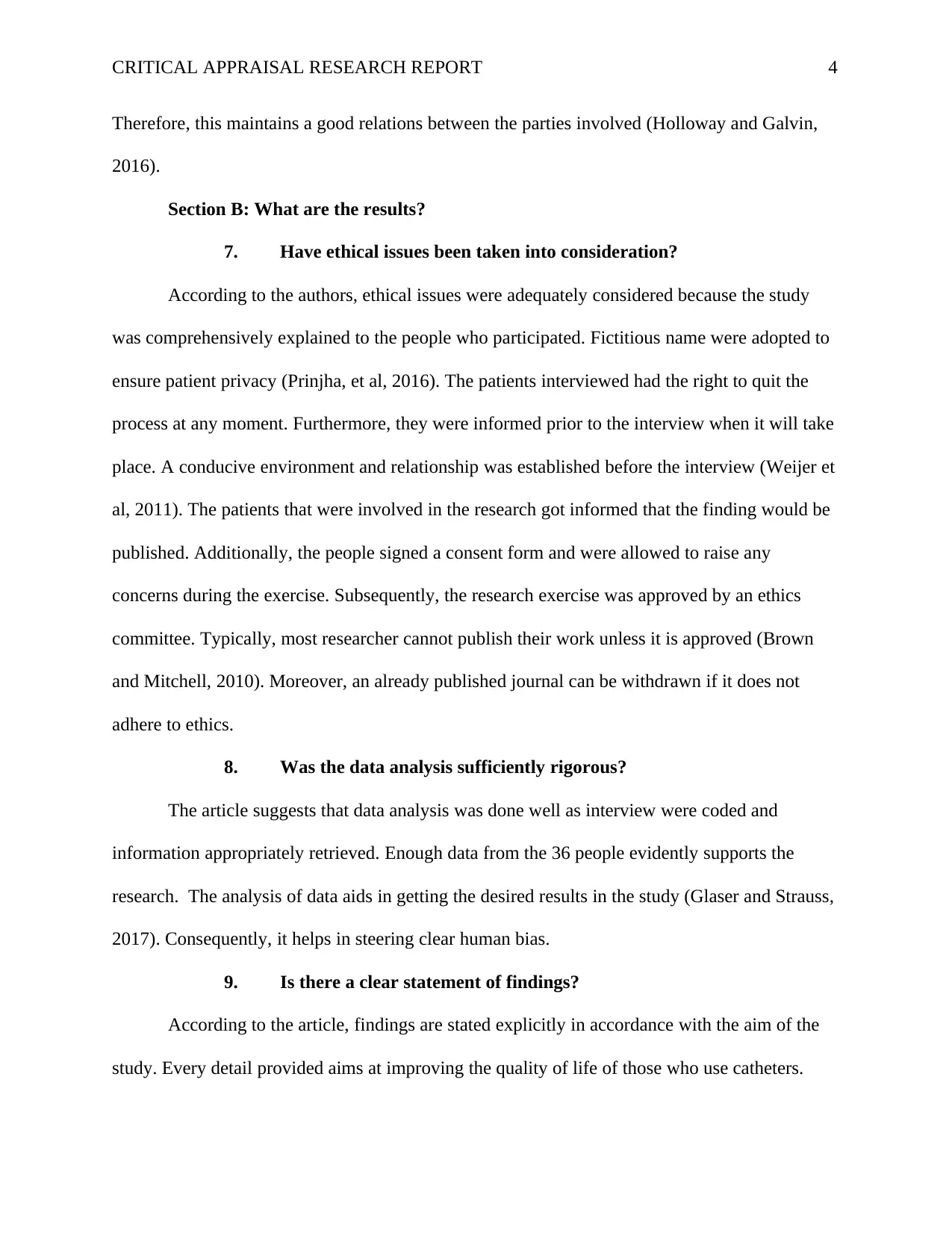
CRITICAL APPRAISAL RESEARCH REPORT 4
Therefore, this maintains a good relations between the parties involved (Holloway and Galvin,
2016).
Section B: What are the results?
7. Have ethical issues been taken into consideration?
According to the authors, ethical issues were adequately considered because the study
was comprehensively explained to the people who participated. Fictitious name were adopted to
ensure patient privacy (Prinjha, et al, 2016). The patients interviewed had the right to quit the
process at any moment. Furthermore, they were informed prior to the interview when it will take
place. A conducive environment and relationship was established before the interview (Weijer et
al, 2011). The patients that were involved in the research got informed that the finding would be
published. Additionally, the people signed a consent form and were allowed to raise any
concerns during the exercise. Subsequently, the research exercise was approved by an ethics
committee. Typically, most researcher cannot publish their work unless it is approved (Brown
and Mitchell, 2010). Moreover, an already published journal can be withdrawn if it does not
adhere to ethics.
8. Was the data analysis sufficiently rigorous?
The article suggests that data analysis was done well as interview were coded and
information appropriately retrieved. Enough data from the 36 people evidently supports the
research. The analysis of data aids in getting the desired results in the study (Glaser and Strauss,
2017). Consequently, it helps in steering clear human bias.
9. Is there a clear statement of findings?
According to the article, findings are stated explicitly in accordance with the aim of the
study. Every detail provided aims at improving the quality of life of those who use catheters.
Therefore, this maintains a good relations between the parties involved (Holloway and Galvin,
2016).
Section B: What are the results?
7. Have ethical issues been taken into consideration?
According to the authors, ethical issues were adequately considered because the study
was comprehensively explained to the people who participated. Fictitious name were adopted to
ensure patient privacy (Prinjha, et al, 2016). The patients interviewed had the right to quit the
process at any moment. Furthermore, they were informed prior to the interview when it will take
place. A conducive environment and relationship was established before the interview (Weijer et
al, 2011). The patients that were involved in the research got informed that the finding would be
published. Additionally, the people signed a consent form and were allowed to raise any
concerns during the exercise. Subsequently, the research exercise was approved by an ethics
committee. Typically, most researcher cannot publish their work unless it is approved (Brown
and Mitchell, 2010). Moreover, an already published journal can be withdrawn if it does not
adhere to ethics.
8. Was the data analysis sufficiently rigorous?
The article suggests that data analysis was done well as interview were coded and
information appropriately retrieved. Enough data from the 36 people evidently supports the
research. The analysis of data aids in getting the desired results in the study (Glaser and Strauss,
2017). Consequently, it helps in steering clear human bias.
9. Is there a clear statement of findings?
According to the article, findings are stated explicitly in accordance with the aim of the
study. Every detail provided aims at improving the quality of life of those who use catheters.
Paraphrase This Document
Need a fresh take? Get an instant paraphrase of this document with our AI Paraphraser
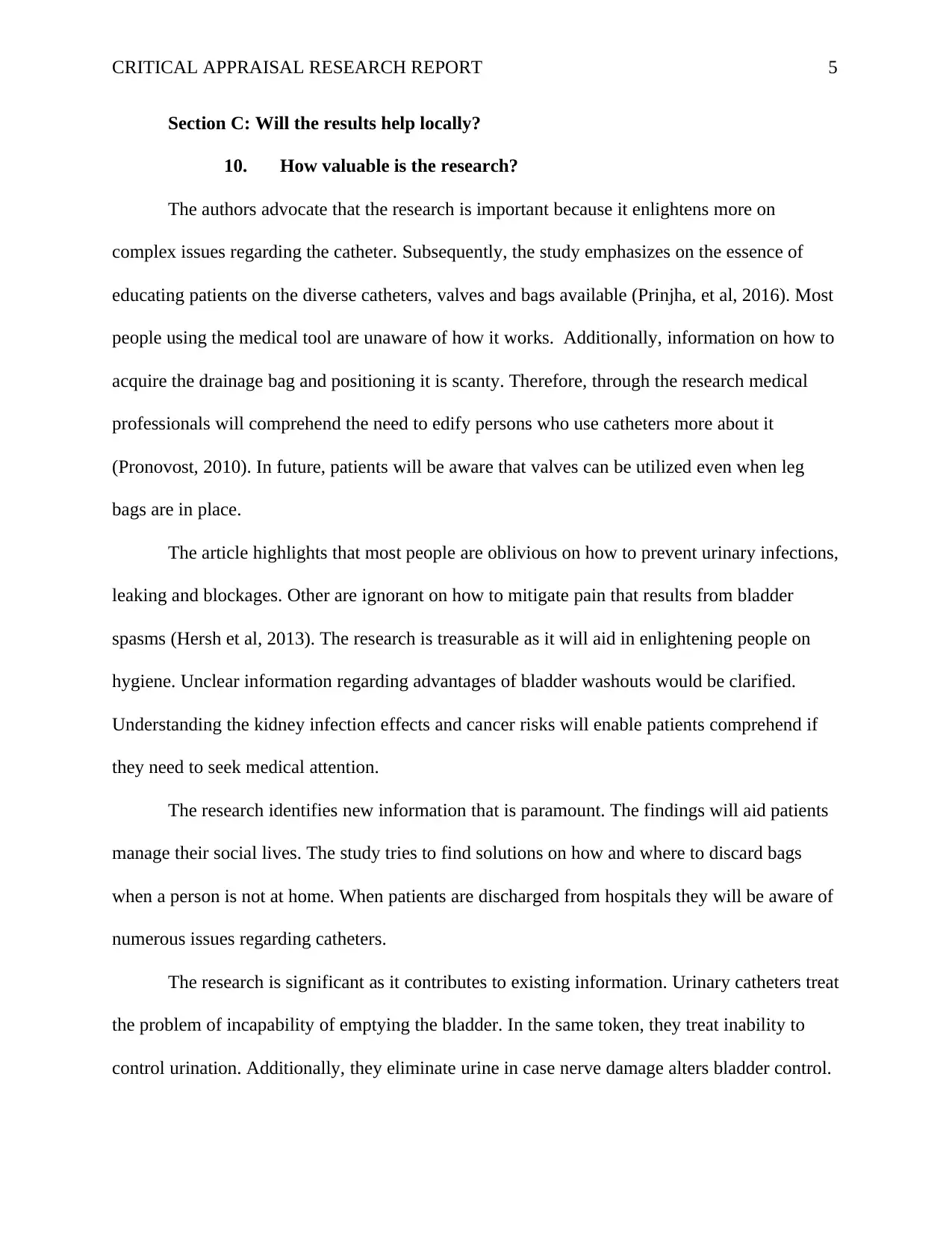
CRITICAL APPRAISAL RESEARCH REPORT 5
Section C: Will the results help locally?
10. How valuable is the research?
The authors advocate that the research is important because it enlightens more on
complex issues regarding the catheter. Subsequently, the study emphasizes on the essence of
educating patients on the diverse catheters, valves and bags available (Prinjha, et al, 2016). Most
people using the medical tool are unaware of how it works. Additionally, information on how to
acquire the drainage bag and positioning it is scanty. Therefore, through the research medical
professionals will comprehend the need to edify persons who use catheters more about it
(Pronovost, 2010). In future, patients will be aware that valves can be utilized even when leg
bags are in place.
The article highlights that most people are oblivious on how to prevent urinary infections,
leaking and blockages. Other are ignorant on how to mitigate pain that results from bladder
spasms (Hersh et al, 2013). The research is treasurable as it will aid in enlightening people on
hygiene. Unclear information regarding advantages of bladder washouts would be clarified.
Understanding the kidney infection effects and cancer risks will enable patients comprehend if
they need to seek medical attention.
The research identifies new information that is paramount. The findings will aid patients
manage their social lives. The study tries to find solutions on how and where to discard bags
when a person is not at home. When patients are discharged from hospitals they will be aware of
numerous issues regarding catheters.
The research is significant as it contributes to existing information. Urinary catheters treat
the problem of incapability of emptying the bladder. In the same token, they treat inability to
control urination. Additionally, they eliminate urine in case nerve damage alters bladder control.
Section C: Will the results help locally?
10. How valuable is the research?
The authors advocate that the research is important because it enlightens more on
complex issues regarding the catheter. Subsequently, the study emphasizes on the essence of
educating patients on the diverse catheters, valves and bags available (Prinjha, et al, 2016). Most
people using the medical tool are unaware of how it works. Additionally, information on how to
acquire the drainage bag and positioning it is scanty. Therefore, through the research medical
professionals will comprehend the need to edify persons who use catheters more about it
(Pronovost, 2010). In future, patients will be aware that valves can be utilized even when leg
bags are in place.
The article highlights that most people are oblivious on how to prevent urinary infections,
leaking and blockages. Other are ignorant on how to mitigate pain that results from bladder
spasms (Hersh et al, 2013). The research is treasurable as it will aid in enlightening people on
hygiene. Unclear information regarding advantages of bladder washouts would be clarified.
Understanding the kidney infection effects and cancer risks will enable patients comprehend if
they need to seek medical attention.
The research identifies new information that is paramount. The findings will aid patients
manage their social lives. The study tries to find solutions on how and where to discard bags
when a person is not at home. When patients are discharged from hospitals they will be aware of
numerous issues regarding catheters.
The research is significant as it contributes to existing information. Urinary catheters treat
the problem of incapability of emptying the bladder. In the same token, they treat inability to
control urination. Additionally, they eliminate urine in case nerve damage alters bladder control.
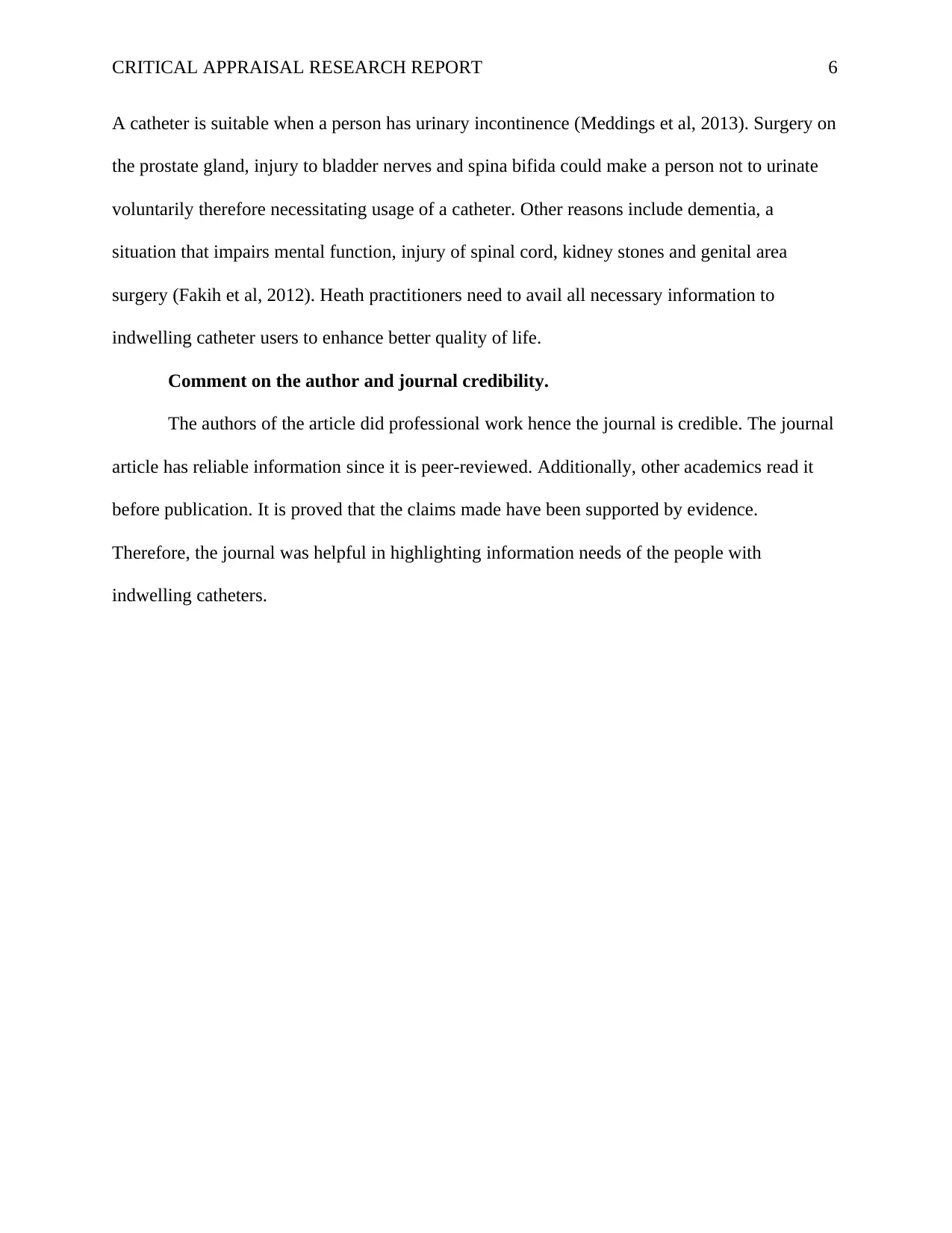
CRITICAL APPRAISAL RESEARCH REPORT 6
A catheter is suitable when a person has urinary incontinence (Meddings et al, 2013). Surgery on
the prostate gland, injury to bladder nerves and spina bifida could make a person not to urinate
voluntarily therefore necessitating usage of a catheter. Other reasons include dementia, a
situation that impairs mental function, injury of spinal cord, kidney stones and genital area
surgery (Fakih et al, 2012). Heath practitioners need to avail all necessary information to
indwelling catheter users to enhance better quality of life.
Comment on the author and journal credibility.
The authors of the article did professional work hence the journal is credible. The journal
article has reliable information since it is peer-reviewed. Additionally, other academics read it
before publication. It is proved that the claims made have been supported by evidence.
Therefore, the journal was helpful in highlighting information needs of the people with
indwelling catheters.
A catheter is suitable when a person has urinary incontinence (Meddings et al, 2013). Surgery on
the prostate gland, injury to bladder nerves and spina bifida could make a person not to urinate
voluntarily therefore necessitating usage of a catheter. Other reasons include dementia, a
situation that impairs mental function, injury of spinal cord, kidney stones and genital area
surgery (Fakih et al, 2012). Heath practitioners need to avail all necessary information to
indwelling catheter users to enhance better quality of life.
Comment on the author and journal credibility.
The authors of the article did professional work hence the journal is credible. The journal
article has reliable information since it is peer-reviewed. Additionally, other academics read it
before publication. It is proved that the claims made have been supported by evidence.
Therefore, the journal was helpful in highlighting information needs of the people with
indwelling catheters.
⊘ This is a preview!⊘
Do you want full access?
Subscribe today to unlock all pages.

Trusted by 1+ million students worldwide
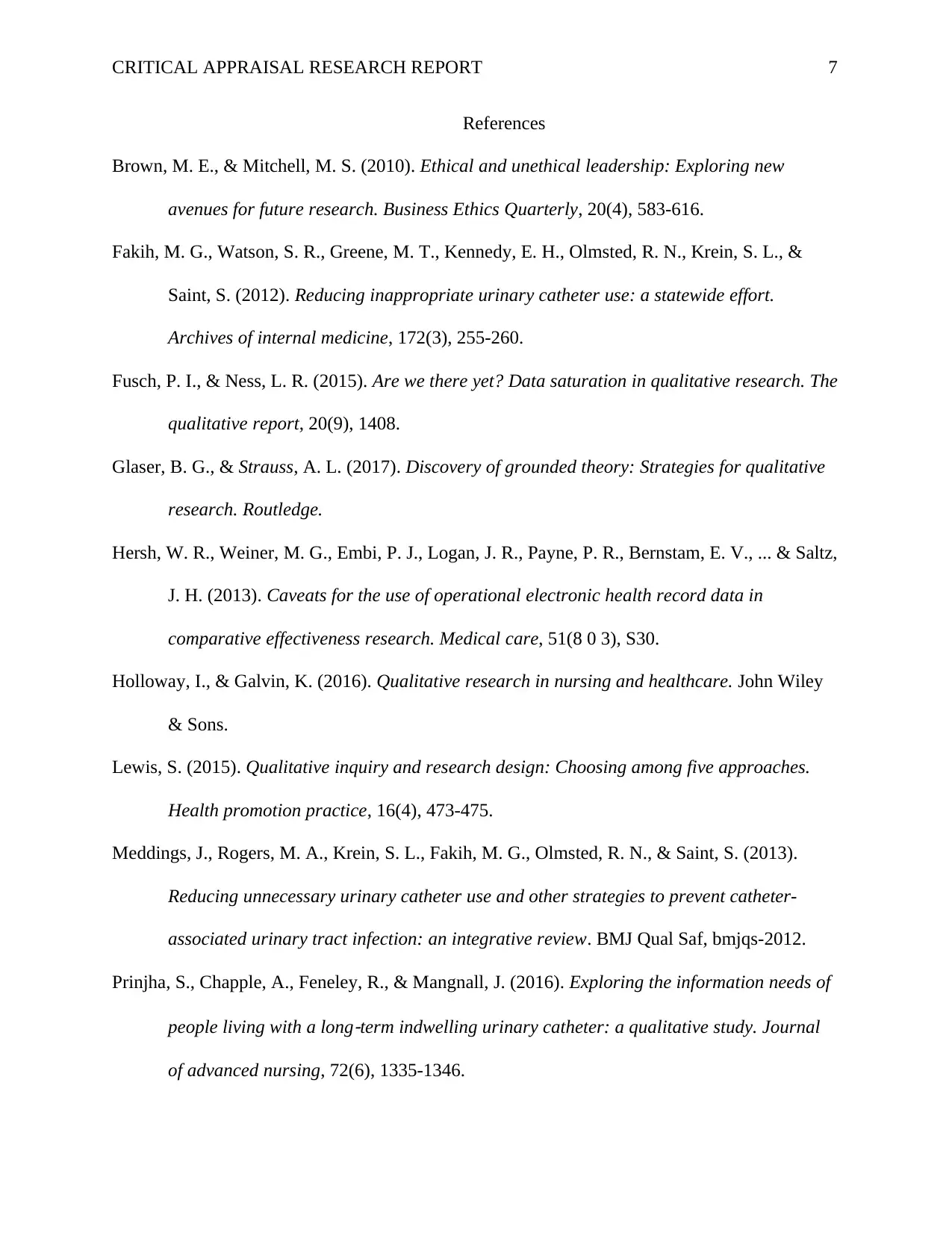
CRITICAL APPRAISAL RESEARCH REPORT 7
References
Brown, M. E., & Mitchell, M. S. (2010). Ethical and unethical leadership: Exploring new
avenues for future research. Business Ethics Quarterly, 20(4), 583-616.
Fakih, M. G., Watson, S. R., Greene, M. T., Kennedy, E. H., Olmsted, R. N., Krein, S. L., &
Saint, S. (2012). Reducing inappropriate urinary catheter use: a statewide effort.
Archives of internal medicine, 172(3), 255-260.
Fusch, P. I., & Ness, L. R. (2015). Are we there yet? Data saturation in qualitative research. The
qualitative report, 20(9), 1408.
Glaser, B. G., & Strauss, A. L. (2017). Discovery of grounded theory: Strategies for qualitative
research. Routledge.
Hersh, W. R., Weiner, M. G., Embi, P. J., Logan, J. R., Payne, P. R., Bernstam, E. V., ... & Saltz,
J. H. (2013). Caveats for the use of operational electronic health record data in
comparative effectiveness research. Medical care, 51(8 0 3), S30.
Holloway, I., & Galvin, K. (2016). Qualitative research in nursing and healthcare. John Wiley
& Sons.
Lewis, S. (2015). Qualitative inquiry and research design: Choosing among five approaches.
Health promotion practice, 16(4), 473-475.
Meddings, J., Rogers, M. A., Krein, S. L., Fakih, M. G., Olmsted, R. N., & Saint, S. (2013).
Reducing unnecessary urinary catheter use and other strategies to prevent catheter-
associated urinary tract infection: an integrative review. BMJ Qual Saf, bmjqs-2012.
Prinjha, S., Chapple, A., Feneley, R., & Mangnall, J. (2016). Exploring the information needs of
people living with a long
‐term indwelling urinary catheter: a qualitative study. Journal
of advanced nursing, 72(6), 1335-1346.
References
Brown, M. E., & Mitchell, M. S. (2010). Ethical and unethical leadership: Exploring new
avenues for future research. Business Ethics Quarterly, 20(4), 583-616.
Fakih, M. G., Watson, S. R., Greene, M. T., Kennedy, E. H., Olmsted, R. N., Krein, S. L., &
Saint, S. (2012). Reducing inappropriate urinary catheter use: a statewide effort.
Archives of internal medicine, 172(3), 255-260.
Fusch, P. I., & Ness, L. R. (2015). Are we there yet? Data saturation in qualitative research. The
qualitative report, 20(9), 1408.
Glaser, B. G., & Strauss, A. L. (2017). Discovery of grounded theory: Strategies for qualitative
research. Routledge.
Hersh, W. R., Weiner, M. G., Embi, P. J., Logan, J. R., Payne, P. R., Bernstam, E. V., ... & Saltz,
J. H. (2013). Caveats for the use of operational electronic health record data in
comparative effectiveness research. Medical care, 51(8 0 3), S30.
Holloway, I., & Galvin, K. (2016). Qualitative research in nursing and healthcare. John Wiley
& Sons.
Lewis, S. (2015). Qualitative inquiry and research design: Choosing among five approaches.
Health promotion practice, 16(4), 473-475.
Meddings, J., Rogers, M. A., Krein, S. L., Fakih, M. G., Olmsted, R. N., & Saint, S. (2013).
Reducing unnecessary urinary catheter use and other strategies to prevent catheter-
associated urinary tract infection: an integrative review. BMJ Qual Saf, bmjqs-2012.
Prinjha, S., Chapple, A., Feneley, R., & Mangnall, J. (2016). Exploring the information needs of
people living with a long
‐term indwelling urinary catheter: a qualitative study. Journal
of advanced nursing, 72(6), 1335-1346.
Paraphrase This Document
Need a fresh take? Get an instant paraphrase of this document with our AI Paraphraser
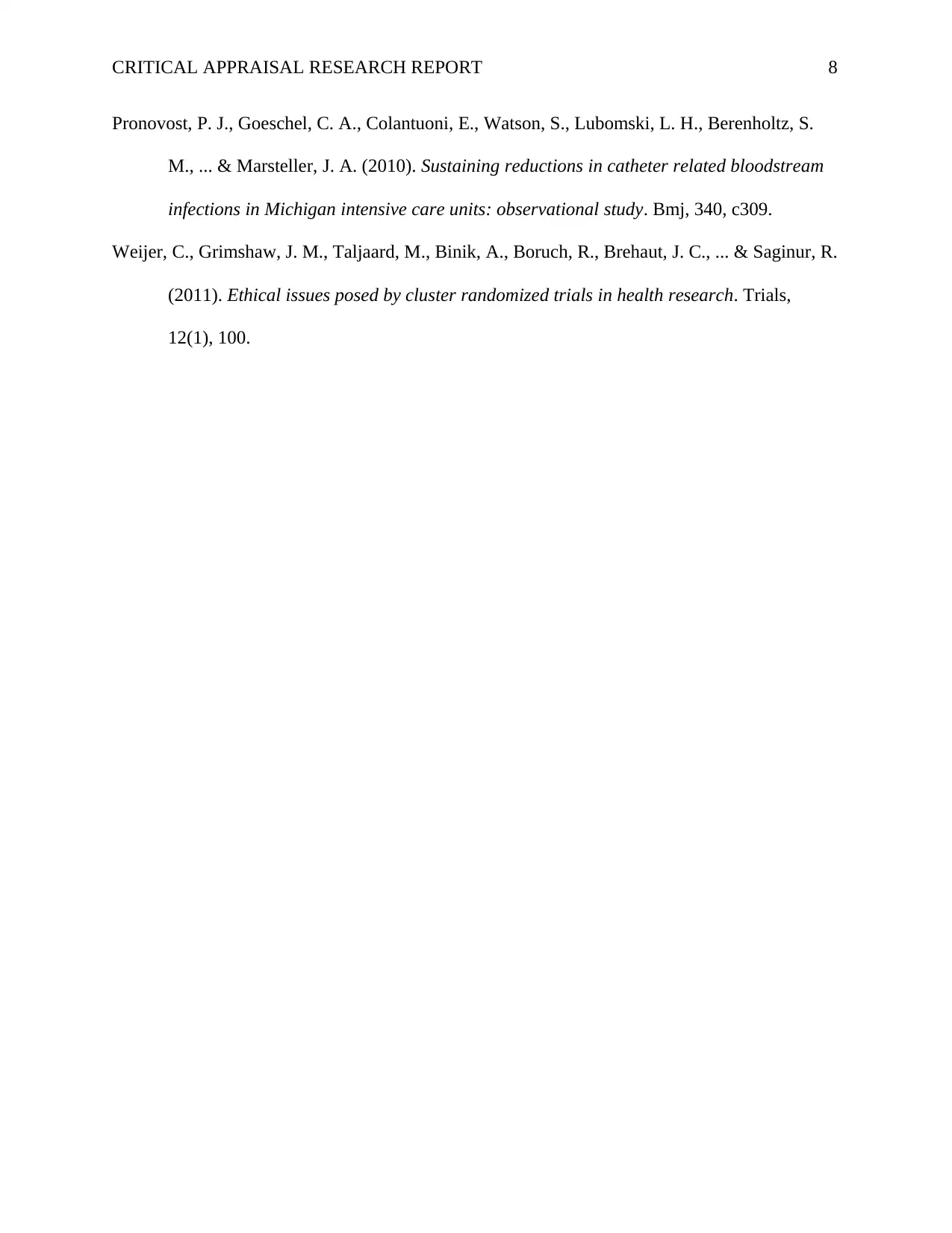
CRITICAL APPRAISAL RESEARCH REPORT 8
Pronovost, P. J., Goeschel, C. A., Colantuoni, E., Watson, S., Lubomski, L. H., Berenholtz, S.
M., ... & Marsteller, J. A. (2010). Sustaining reductions in catheter related bloodstream
infections in Michigan intensive care units: observational study. Bmj, 340, c309.
Weijer, C., Grimshaw, J. M., Taljaard, M., Binik, A., Boruch, R., Brehaut, J. C., ... & Saginur, R.
(2011). Ethical issues posed by cluster randomized trials in health research. Trials,
12(1), 100.
Pronovost, P. J., Goeschel, C. A., Colantuoni, E., Watson, S., Lubomski, L. H., Berenholtz, S.
M., ... & Marsteller, J. A. (2010). Sustaining reductions in catheter related bloodstream
infections in Michigan intensive care units: observational study. Bmj, 340, c309.
Weijer, C., Grimshaw, J. M., Taljaard, M., Binik, A., Boruch, R., Brehaut, J. C., ... & Saginur, R.
(2011). Ethical issues posed by cluster randomized trials in health research. Trials,
12(1), 100.
1 out of 8
Related Documents
Your All-in-One AI-Powered Toolkit for Academic Success.
+13062052269
info@desklib.com
Available 24*7 on WhatsApp / Email
![[object Object]](/_next/static/media/star-bottom.7253800d.svg)
Unlock your academic potential
Copyright © 2020–2026 A2Z Services. All Rights Reserved. Developed and managed by ZUCOL.




